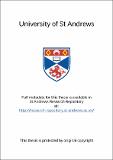Files in this item
Marine benthic system function and biodiversity
Item metadata
| dc.contributor.advisor | Patterson, David | en |
| dc.contributor.advisor | Raffaelli, David | en |
| dc.contributor.author | Biles, Catherine Lucy | en |
| dc.coverage.spatial | 260 p | en |
| dc.date.accessioned | 2021-04-08T08:59:36Z | |
| dc.date.available | 2021-04-08T08:59:36Z | |
| dc.date.issued | 2003 | |
| dc.identifier.uri | https://hdl.handle.net/10023/21955 | |
| dc.description.abstract | Understanding the influence of biodiversity on the functioning of ecosystems is vital given current rates of species loss. The relationship between biodiversity and ecosystem functioning was explored in marine sediment systems, where few studies have investigated biodiversity-ecosystem functioning relationships. In addition, the influence of flow on these processes was examined, as this is an important abiotic factor in marine benthic systems. Ecosystem functioning was measured by nutrient concentration in the water column above the sediment, particle redistribution, particle resuspension, sediment shear strength and microbial community composition and activity. Benthic chambers with flow facility were designed and the flow rate calibrated. The chambers were used in both laboratory and in situ experiments to assess the effect of macrofauna in single species and multispecies treatments on these aspects of the functioning of the system. Species richness, species evenness and functional trait richness were varied in order to assess the effects of different measures of diversity on the functioning of the system. Single species treatments had highly variable effects on ecosystem functioning, probably resulting from differences in species behavioural traits. Species diversity was found to have significant effects on ecosystem functioning, with functional richness accounting for most variation. Functional richness was the only measure of diversity to consider the influence of species behaviour on the ecosystem and therefore best explained the changes in ecosystem functioning. Flow was found to have a significant effect on nutrient concentration in the presence of macrofauna. Microbial activity was also affected by flow, though species treatment alone had no discernible affect. Flow may therefore be acting to alter macrofaunal behaviour, which changes microbial activity, affecting nutrient cycling processes. This work showed the importance of biodiversity-functioning relationships in a marine sediment system, with results providing most support for the idiosyncratic model describing ecosystem response to biodiversity. | en |
| dc.language.iso | en | en |
| dc.publisher | University of St Andrews | en |
| dc.subject.lcc | QH541.5B5 | |
| dc.subject.lcsh | Marine benthic ecology | en |
| dc.subject.lcsh | Marine habitats | en |
| dc.title | Marine benthic system function and biodiversity | en |
| dc.type | Thesis | en |
| dc.type.qualificationlevel | Doctoral | en |
| dc.type.qualificationname | PhD Doctor of Philosopy | en |
| dc.publisher.institution | The University of St Andrews | en |
This item appears in the following Collection(s)
Items in the St Andrews Research Repository are protected by copyright, with all rights reserved, unless otherwise indicated.

